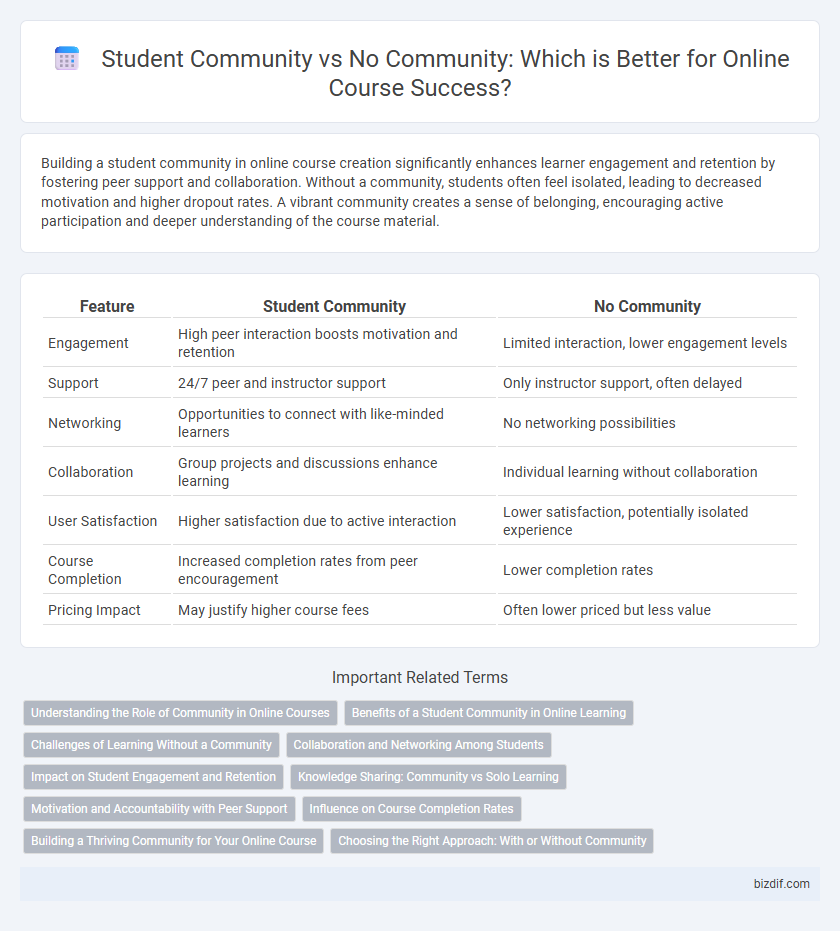Building a student community in online course creation significantly enhances learner engagement and retention by fostering peer support and collaboration. Without a community, students often feel isolated, leading to decreased motivation and higher dropout rates. A vibrant community creates a sense of belonging, encouraging active participation and deeper understanding of the course material.
Table of Comparison
| Feature | Student Community | No Community |
|---|---|---|
| Engagement | High peer interaction boosts motivation and retention | Limited interaction, lower engagement levels |
| Support | 24/7 peer and instructor support | Only instructor support, often delayed |
| Networking | Opportunities to connect with like-minded learners | No networking possibilities |
| Collaboration | Group projects and discussions enhance learning | Individual learning without collaboration |
| User Satisfaction | Higher satisfaction due to active interaction | Lower satisfaction, potentially isolated experience |
| Course Completion | Increased completion rates from peer encouragement | Lower completion rates |
| Pricing Impact | May justify higher course fees | Often lower priced but less value |
Understanding the Role of Community in Online Courses
Student communities in online courses foster engagement, collaboration, and peer support, significantly enhancing learners' motivation and knowledge retention. Courses lacking a community component often experience lower completion rates and reduced learner satisfaction due to isolation and limited interaction. Building an active student community is critical for creating an immersive and supportive learning environment that drives course success.
Benefits of a Student Community in Online Learning
A student community in online learning fosters active engagement, boosting knowledge retention and motivation through peer support and shared experiences. Collaborative environments enhance problem-solving skills and provide diverse perspectives, enriching the overall learning journey. Without a community, students often face isolation, leading to decreased accountability and higher dropout rates.
Challenges of Learning Without a Community
Learning without a student community often leads to isolation, reducing motivation and engagement in online courses. The absence of peer support limits opportunities for collaborative problem-solving and feedback, hindering deep understanding of course material. Without community interaction, students face challenges in maintaining accountability and overcoming difficulties independently, which can result in higher dropout rates.
Collaboration and Networking Among Students
Student communities in online courses foster collaboration by enabling peer-to-peer interaction, group projects, and shared problem-solving activities that enhance learning outcomes. Networking opportunities within these communities help students build professional relationships, exchange industry insights, and support career advancement. Courses without student communities often lack these interactive benefits, resulting in isolated learning experiences and reduced motivation.
Impact on Student Engagement and Retention
Students participating in online courses with a dedicated community exhibit 40% higher engagement levels and a 30% increase in course completion rates compared to those without access to a peer network. Active discussion forums and peer interaction foster motivation and accountability, directly contributing to improved retention. The presence of a student community enhances learning outcomes by creating a supportive environment that reduces dropout rates.
Knowledge Sharing: Community vs Solo Learning
Student communities in online courses significantly enhance knowledge sharing by enabling peer-to-peer interactions, collaborative problem-solving, and diverse perspectives that enrich the learning experience. Solo learning lacks these dynamic exchanges, often limiting insight to instructor content and individual reflection. Research shows courses with active communities improve engagement and retention rates by fostering continuous dialogue and mutual support among learners.
Motivation and Accountability with Peer Support
Student communities in online course creation significantly boost motivation and accountability by fostering peer support and shared learning experiences. Without a community, learners often struggle with isolation, leading to decreased engagement and higher dropout rates. Peer interactions encourage consistent progress and provide emotional reinforcement essential for course completion.
Influence on Course Completion Rates
Online courses with active student communities show significantly higher completion rates, often improving retention by up to 50%. Peer interaction fosters motivation, accountability, and deeper engagement, which are critical factors influencing course success. Conversely, courses lacking a community struggle with learner isolation, leading to increased dropout rates and reduced overall effectiveness.
Building a Thriving Community for Your Online Course
Building a thriving community within your online course enhances student engagement, promotes peer-to-peer learning, and increases course completion rates. Courses with active communities see higher student satisfaction and retention compared to those without, as learners gain support and motivation from interaction. Investing in community-building tools such as discussion forums, live Q&A sessions, and social media groups fosters a collaborative environment that drives long-term course success.
Choosing the Right Approach: With or Without Community
Building a student community within an online course significantly enhances engagement, peer support, and knowledge retention, which leads to higher completion rates and better learning outcomes compared to courses without community features. Courses without a community may benefit from simplicity and reduced management overhead, but they risk lower interaction and student motivation. Choosing the right approach depends on the course content, target audience, and resource availability for fostering meaningful student connections.
Student community vs No community Infographic

 bizdif.com
bizdif.com